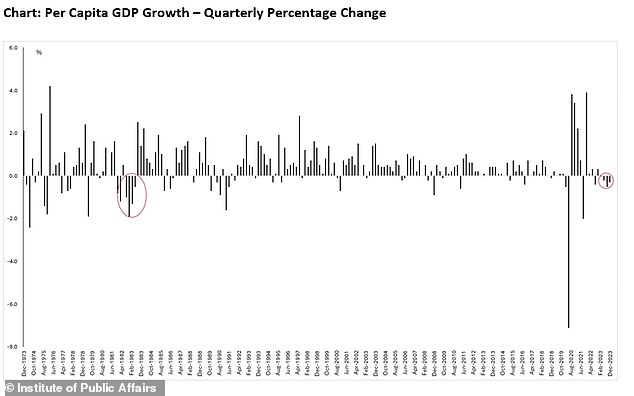The disturbing figures Jim Chalmers doesn’t want to talk about – here’s why you should be worried about Australia’s worst economic crisis in 40 years
One worrying figure was conspicuously missing from Jim Chalmers’ update on Australia’s ‘moderate’ economic growth – despite it showing the worst crisis in four decades.
The treasurer announced on Wednesday that the economy had grown “a little bit, but not much”, reassuring the country that it was “stable”.
Official national accounts data show that the economy grew by just 0.2 percent in the last three months of 2023 and by 1.5 percent over the year – or almost half of 2.7 percent by 2022.
But Dr Chalmers did not address how Australia is experiencing its worst per capita recession in four decades, with output for every worker either flat or declining.
Declining production and productivity is bad economic news because it means companies produce fewer goods and services and have to pass the costs on to consumers to make a profit.
This threatens living standards and could potentially keep inflation high for longer, delaying potential rate cuts by the Reserve Bank, experts warn.
Treasurer Jim Chalmers has said nothing about Australia’s worst per capita recession in 40 years, with output for every worker in decline
Record high immigration is blamed for Australia’s worst economic crisis in four decades.
The new national accounts data shows gross domestic product per capita contracted by 1 percent in 2023, following a 0.3 percent decline in the December quarter.
Australia has been in per capita recession since the March 2023 quarter, where GDP per capita has contracted.
This followed a flat performance in the December quarter of 2022, which saw no growth.
The National Accounts data from the Australian Bureau of Statistics shows this the worst per capita recession since 1983 – the last time GDP per capita shrank or leveled off for four quarters in a row.
But in his 864-word media statement, Dr Chalmers made no mention of the per capita recession as he acknowledged that overall economic growth was slowing.
“Today’s national accounts show Australian growth is moderate but stable, despite higher interest rates, high but moderating inflation and persistent global uncertainty,” he said.
‘The economy grew a little, but not much. Even weak growth is welcome growth given the circumstances.’
But Daniel Wild, deputy director of the Institute of Public Affairs, said a per capita recession is worrying.
“For the fourth quarter in a row, GDP per capita, a much more accurate measure of living standards than overall economic growth, has fallen, meaning Australians are going backwards,” he said.
‘The last time there was a decline in GDP per capita in four consecutive quarters was more than forty years ago, in 1983.

Australia has been in per capita recession since the March 2023 quarter, where GDP per capita has shrunk – marking its worst crisis since 1983 (pictured is a Sydney traffic controller)

Record high immigration blamed for Australia’s worst economic crisis in four decades (pictured at Sydney’s Town Hall train station)
“The declining GDP per capita has been caused by the federal government’s unplanned mass migration program.
“While the overall size of the economic pie is growing, Australians are being left with a smaller share.”
Productivity also fell 0.4 percent last year, but rose 0.5 percent in the December quarter.
AMP chief economist Shane Oliver, another critic of high immigration, noted that Australia also suffered per capita recessions in the early 1990s, in the 2000s and on either side of the pandemic in 2020.

Daniel Wild, deputy director of the Institute of Public Affairs, said the worst per capita recession is a cause for concern
But he expected the worst to be over with the Reserve Bank’s interest rate at a 12-year high of 4.35 percent, following an 18-month rise on November 13.
‘A per capita ‘recession’ has occurred several times in the past and while weak per capita growth is negative for living standards, we expect an improvement in GDP per capita as population growth slows and GDP growth starts to improve again later this year. Doctor Oliver said.
A record 518,000 migrants moved to Australia in the 2022-2023 financial year.
The Ministry of Finance expects this number to decrease to 375,000 in 2023-2024.
